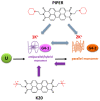Polymorphic and Higher-Order G-Quadruplexes as Possible Transcription Regulators: Novel Perspectives for Future Anticancer Therapeutic Applications
- PMID: 35337170
- PMCID: PMC8950063
- DOI: 10.3390/ph15030373
Polymorphic and Higher-Order G-Quadruplexes as Possible Transcription Regulators: Novel Perspectives for Future Anticancer Therapeutic Applications
Abstract
In the past two decades, significant efforts have been put into designing small molecules to target selected genomic sites where DNA conformational rearrangements control gene expression. G-rich sequences at oncogene promoters are considered good points of intervention since, under specific environmental conditions, they can fold into non-canonical tetrahelical structures known as G-quadruplexes. However, emerging evidence points to a frequent lack of correlation between small molecule targeting of G-quadruplexes at gene promoters and the expression of the associated protein, which hampers pharmaceutical applications. The wide genomic localization of G-quadruplexes along with their highly polymorphic behavior may account for this scenario, suggesting the need for more focused drug design strategies. Here, we will summarize the G4 structural features that can be considered to fulfill this goal. In particular, by comparing a telomeric sequence with the well-characterized G-rich domain of the KIT promoter, we will address how multiple secondary structures might cooperate to control genome architecture at a higher level. If this holds true, the link between drug-DNA complex formation and the associated cellular effects will need to be revisited.
Keywords: G-quadruplex; folding landscapes; gene promoters.
Conflict of interest statement
The authors declare no conflict of interest.
Figures






Similar articles
-
G-quadruplexes in human promoters: A challenge for therapeutic applications.Biochim Biophys Acta Gen Subj. 2017 May;1861(5 Pt B):1399-1413. doi: 10.1016/j.bbagen.2016.12.024. Epub 2016 Dec 24. Biochim Biophys Acta Gen Subj. 2017. PMID: 28025083 Review.
-
Emerging Role of G-quadruplex DNA as Target in Anticancer Therapy.Curr Pharm Des. 2016;22(44):6612-6624. doi: 10.2174/1381612822666160831101031. Curr Pharm Des. 2016. PMID: 27587203 Review.
-
G-quadruplex structures in the human genome as novel therapeutic targets.Molecules. 2013 Oct 8;18(10):12368-95. doi: 10.3390/molecules181012368. Molecules. 2013. PMID: 24108400 Free PMC article. Review.
-
Recent Update on Targeting c-MYC G-Quadruplexes by Small Molecules for Anticancer Therapeutics.J Med Chem. 2021 Jan 14;64(1):42-70. doi: 10.1021/acs.jmedchem.0c01145. Epub 2020 Dec 23. J Med Chem. 2021. PMID: 33355454 Review.
-
DNA G-quadruplex and its potential as anticancer drug target.Sci China Chem. 2014 Dec;57(12):1605-1614. doi: 10.1007/s11426-014-5235-3. Epub 2014 Nov 15. Sci China Chem. 2014. PMID: 27182219 Free PMC article.
Cited by
-
Polymeric Properties of Telomeric G-Quadruplex Multimers: Effects of Chemically Inert Crowders.Biomacromolecules. 2025 May 12;26(5):3128-3138. doi: 10.1021/acs.biomac.5c00176. Epub 2025 Apr 8. Biomacromolecules. 2025. PMID: 40199738 Free PMC article.
-
Epigenomic Features and Potential Functions of K+ and Na+ Favorable DNA G-Quadruplexes in Rice.Int J Mol Sci. 2022 Jul 29;23(15):8404. doi: 10.3390/ijms23158404. Int J Mol Sci. 2022. PMID: 35955535 Free PMC article.
-
Structural elucidation of HIV-1 G-quadruplexes in a cellular environment and their ligand binding using responsive 19F-labeled nucleoside probes.Chem Sci. 2024 Apr 25;15(21):7982-7991. doi: 10.1039/d4sc01755b. eCollection 2024 May 29. Chem Sci. 2024. PMID: 38817587 Free PMC article.
-
Structural Polymorphism of Guanine Quadruplex-Containing Regions in Human Promoters.Int J Mol Sci. 2022 Dec 16;23(24):16020. doi: 10.3390/ijms232416020. Int J Mol Sci. 2022. PMID: 36555662 Free PMC article.
References
Grants and funding
LinkOut - more resources
Full Text Sources
Miscellaneous

